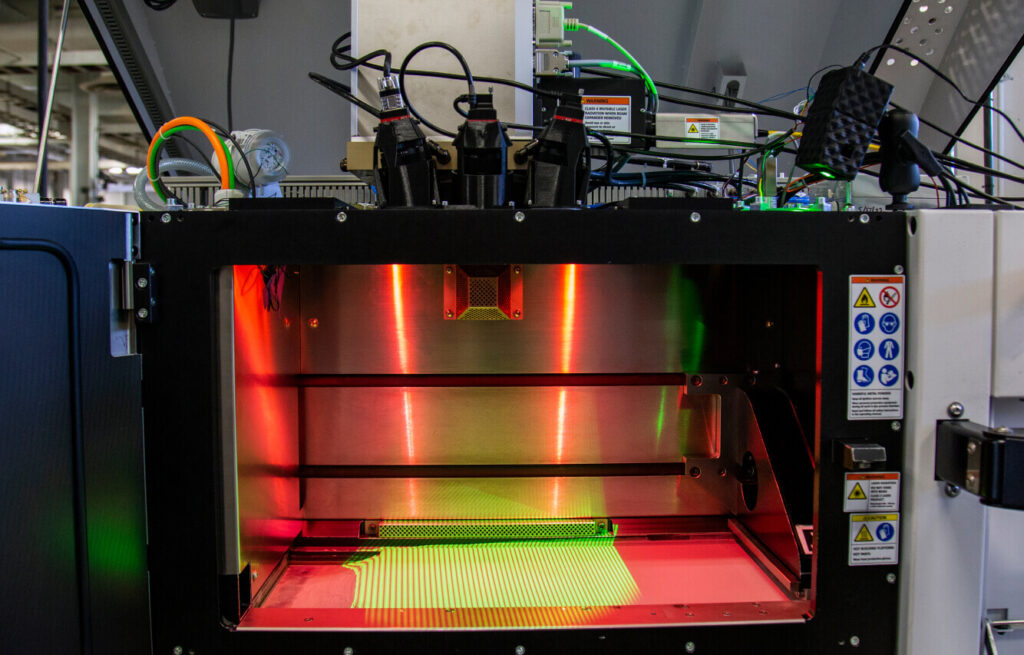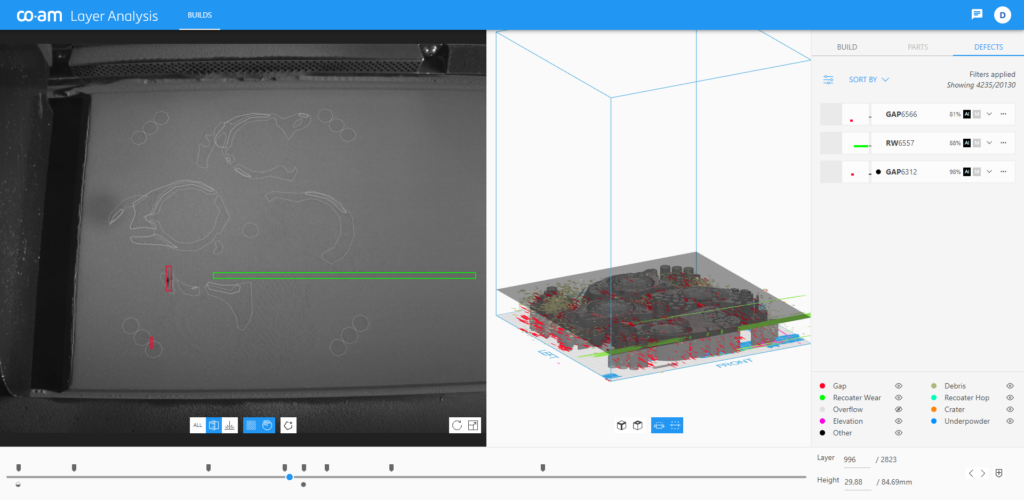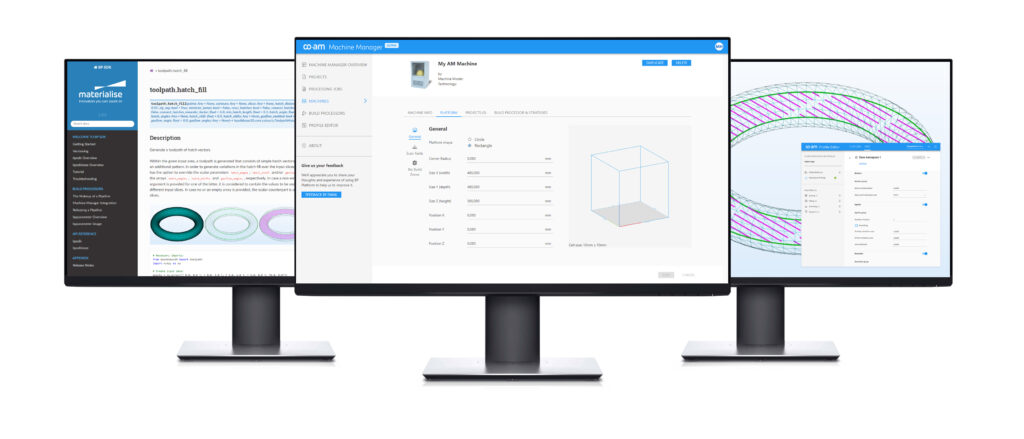Interview: Materialise Adds Further 3D Printing Quality Control to CO-AM
Since its acquisition of manufacturing execution software (MES) developer Link3D, Materialise (Nasdaq: MTLS) has gone all in on fleshing out its CO-AM platform. The additive manufacturing (AM) software developer is building a complete ecosystem for enabling production with 3D printing technology.
Naturally, a core piece of such an environment is quality control, which is why, at the 2023 Additive Manufacturing Users Group (AMUG) Conference, the company announced the addition of Phase3D and Sigma Additive Solutions to its CO-AM platform. At the event, we spoke to Bryan Crutchfield, Vice President and General Manager of Materialise North America, to learn more.
As a part of a new CO-AM module called Materialise Process Control, the company combined Phase3D’s ability to perform topographical mapping inside of a build platform and Sigma Additive’s ability to perform thermal sensing with its own artificial intelligence (AI) algorithms to consistently monitor the melt pool in metal powder bed fusion (PBF). Altogether, the module is able to automatically check all of the build layers to ensure that they were made correctly.

Phase3D’s Project Fringe quality control hardware mounted to a 3D printer. Image courtesy of Phase3D.
Though Sigma has been building its thermal imaging quality control technology for some time, Phase3D is newcomer to the AM sector. Whereas the typical method of quality control relies on a system of cameras to capture light and shadow to look for errors, Phase3D’s technology relies on white light scanning to pick up spatter from the melt pool in a metal PBF system and register defects. This allows the company to distinguish between something as minor as a recoater streak and an actual anomaly, to the point where it can register errors as fine as 10 microns.
As it stands, Materialise Process Control does not interrupt the 3D printing process. Instead, it automatically points out issues within a build so that users can examine the data captured from the print to confirm errors. In turn, it’s possible to save time that might otherwise be spent x-raying components by detecting issues earlier on in the production workflow. This is obviously increasingly important as users move from individual parts to batch production.

Screenshot of Materialise Process Control user interface. Image courtesy of Materialise.
“People have tested the technology. Most of the large companies out there all know it now. They know what it’s capable of and what it’s not capable of yet, and they’re finding their niches,” Crutchfield explained. “And now, they’re turning it into a production tool. So, it becomes important when you get into that serial production, that repeatability and quality systems ensure that you’re reliably producing quality parts each and every time.”
The holy grail for such a process would be automated in-process quality control, which would compensate for errors during printing, rather than solely providing data related to those issues once a print job is complete. For Materialise to obtain such capabilities, it would be necessary to have a close-knit relationship with machine makers. However, to get to that point, the existing Materialise Process Control demonstrates to the market the viability and value of such a technology to original equipment manufacturers.

Also announced was the Build Processor Software Development Kit, which allows companies to adapt Materialise Build Processors to integrate their own APIs. Image courtesy of Materialise.
There are 3D printing machine builders that have developed their own in-house solutions to in-process quality control. Albeit, these tools are limited to users of the specific machines.
“Let’s be honest, they’re not the first ones to try. You can have some success doing that. It’s the Sony Beta Max model, where they try to keep it all to themselves, including the machine,” Crutchfield said. “Ultimately, VHS is what was successful because it was open. People could build on the open platform. It’s what makes smartphones successful as well. They’re semi-open platforms. You know, my mobile phone will have a, a Google app, an Apple app, and a Microsoft app on it. That’s the successful business model in our mind. That’s why we embrace that every day.”
Materialise is a famously open company, attempting to serve the entire 3D printing industry. The CO-AM platform is one way that it’s allowing potential competitors into the same ecosystem.
“We intend for the CO-AM platform to be the neutral and open backbone of AM, so people can put together seamless workflows,” Crutchfield said. “But, you have to be humble enough to realize there’s going to be things that you’re really good at, and there’s going to be some things that somebody might be slightly better at. Maybe they have a better topological optimization tool, or what have you. It could be any number of things where they’re just laser-focused on one specific piece, whereas we’re trying to build a digital ecosystem for everybody to use and work in.”
Demonstrating the firm’s over 30 years of experience, Crutchfield was realistic in his assessment of the overall market. Regardless of how powerful any given software tool is, it can never fully dominate or exist alone. Even if Materialise were able to become the sole provider of AM software, there would still be companies like Oracle and SAP with which its software would have to interface.
As proven by its acquisition of Link3D for MES and Identify3D for cloud security, Materialise isn’t satisfied with a stagnant position, either. If the firm spots an opportunity or gap in its portfolio, it will grow inorganically.
“That’s the reason we keep a large war chest,” Crutchfield said. “I mean we’re financially really strong. The most recent acquisition was Identify3D because we started to see that security was becoming a much more prevalent question at the top of our customer’s minds, even for our traditional magic products. The opportunity came along to acquire Identify3D, which took us to the next level where we’re the most secure platform available in the industry.”
Materialise plans on continuing to be a central piece of the AM industry going forward, which will mean adapting to new trends in terms of artificial intelligence or the expansion of Chinese OEMs in the marketplace. The next steps for the company will likely involve CO-AM and expanding the providers on the platform. However, despite its 30-year history, Materialise is always capable of surprises.
Subscribe to Our Email Newsletter
Stay up-to-date on all the latest news from the 3D printing industry and receive information and offers from third party vendors.
Print Services
You May Also Like
Nanoscribe’s New Clear Material Designed for Optical Electronics
Nanoscribe has launched IPX-Clear, a Two-Photon Polymerization (2PP) material with high transparency, designed for dimensionally accurate components. Optimized for Nanoscribe’s Two-Photon Grayscale Lithography (2GL) process, this resin enables rapid production...
ESA Funds Horizon Microtechnologies’ Metallized 3D Printed Electronics Parts
German small-scale manufacturing expert Horizon Microtechnologies has received the European Space Agency (ESA)’s Spark funding to apply its specialty metallization technology to space applications. The firm believes its parts can...
Bioprinting Strategies: The Robin Hoods of Wake Forest
Rue to those aspiring to be modern-day Robin Hoods of Wake Forest: the path to riches in bioprinting is fraught with challenges. It’s perplexing that the media has not fully...
The Bioprinting Frontier: Key Trends Driving Innovation
With the release of 3DPrint.com‘s updated bioprinting world map, the dynamic shifts within the bioprinting sector come into focus. While the map shares a global view of where key companies...

























